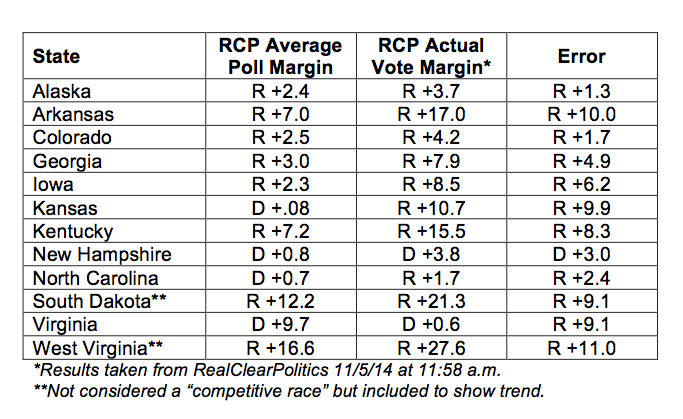Polling Fail: Democrats, Even More Than Libertarians, Underperformed in 2014 Midterms
An unexpectedly strong showing for the GOP shows pollsters still have work to do.

As expected, Libertarian Party candidates continued their streak of not winning any Senate seats or governorships last night. But their performance wasn't all bad. In Vermont, Dan Feliciano surprised even Libertarian Party executive director Wes Benedict by corralling enough support to prevent either major party candidate from achieving the necessary majority. In Virginia, the race for Senate remains too close to call and evidence is mounting that Libertarian Rob Sarvis may indeed have played spoiler to Republican Ed Gillespie—not that the former's voters are obligated to be sad about it.
Polls in recent months had some third-party candidates making unexpected runs, at times into the double digits. One of the big questions going in to Tuesday night was whether those polls would prove accurate. Now that (most of) the ballots have been tabulated, the post mortem can begin: How did pollsters do?
In fact, they missed by far larger margins when it came to predicting Democratic support than support for third parties. On the latter count, results were about what you might expect: The polls overstated support for candidates like Sarvis and Florida gubernatorial hopeful Adrian Wyllie. But the errors were relatively small, mostly because it's hard to be off by much when a candidate's predicted vote share is under 10 percent to begin with.
What virtually nobody expected was that the polls might be systematically overstating Democratic support. But in state after state, that turns out to have been exactly what was going on. Republicans overperformed expectations in basically every competitive Senate race.
A Fairly Uninspired Night for Libertarians
More than a month ago on Reason's Hit & Run blog, I laid out why this year's Libertarians were likely to disappoint:
The problem is that third party candidates don't just fail to win elections—historically, they do even worse at the ballot box than polling would suggest. …
It seems voters find it easier to tell an interviewer they're going to punch the box beside the name of a third party candidate than they do to follow through with that pledge. One theory is that it feels good to describe yourself as the kind of person who's willing to take a principled stand—but in the privacy of the voting booth, the downsides of "throwing your ballot away" on someone you know can't win overpower the upsides of helping a candidate you like make a strong symbolic showing.
So did that trend break in 2014?
Let's start with Sean Haugh, the North Carolinian trumpeted as a "pizza man" who could determine control of the U.S. Senate. Polls going back to June had the Libertarian garnering as much as 11 percent of the vote. Haugh's final RealClearPolitics polling average was a bit lower than that at 4.9 percent. His actual vote share on election night was lower still: 3.7 percent.
Sarvis, the Libertarian candidate for Senate from Virginia, ended the night with 2.5 percent of the vote, compared to the 4 percent the final polling average gave him. Florida's Wyllie finished with 3.8 percent—not terrible, but also not the 6.3 percent his polling average had him at.
In all three states, the L.P. candidate slightly underperformed pollsters' expectations. But that doesn't mean they didn't affect the outcome. Haugh, Sarvis, and Wyllie each took enough of the electorate to "cover the spread," or flip the election from one major party candidate to the other, at least in theory.
In Georgia, the Libertarian candidate didn't even manage that. Amanda Swafford, a former city council member and paralegal, received just 1.9 percent of the vote. A poll taken on Halloween had her at 3 percent among those likely to turn out. The Republican, David Perdue, captured the seat by margin of nearly 8 percentage points, meaning that even if all of Swafford's supporters had inexplicably gone for his opponent, it would not have made a difference.
A slew of Libertarians in other states performed more or less as polls forecasted: Kentucky's Libertarian Senate hopeful, David Patterson, grabbed 3.1 percent. Surveys from October had him in the 2–5 percent range. Illinois and Arizona had Libertarians running for governor who were expected to earn between 3 percent and 7 percent; both got more than 3 percent but less than 4 percent. Same for Alaska's L.P. Senate hopeful.
Few L.P. Surprises Doesn't Mean No Surprises
Dan Feliciano, the L.P. gubernatorial candidate from Vermont, seemed to come out of nowhere. In a YouGov poll taken two weeks before the election, his name wasn't even included, though a different third-party hopeful, Emily Peyton, was. Yet Feliciano got 4.4 percent to Peyton's 1.7 percent. His showing amounts to a little more than 8,300 votes, but it's still far higher than anyone was expecting—and, more to the point, gives the state legislature the power to choose its next governor.
In South Dakota, independent Senate candidate Larry Pressler finished with 17 percent. That's not enough to cover the spread in the bright-red state, but it's quite a showing nonetheless.
And then there's Rhode Island. That's the state where, unbeknownst to even serious election watchers, the Gandalf-esque Bob Healey has been campaigning for governor. Healey, pictured at the top of this article—you won't want to deprive yourself of a look—had previously run for lieutenant governor on a platform to abolish his own office. This year he set his sights even higher, switching affiliations from Cool Moose Party (of which he's founder) to Moderate. As of the middle of last month, one poll found him at just 8.1 percent. The Democrat, Gina Raimondo, was never really in danger of losing. But Healey still managed to earn an astounding 22 percent vote share, or more than five times her margin of victory.
The GOP Wave Materializes
In the run-up to Tuesday's election, some people discussed the possibility that this year's polls might be "systematically" off the mark. But hardly anyone floated the notion that they might be spitting out findings that were too optimistic for Democrats. The HuffPollster newsletter from October 29 noted that "polling in the 2006 and 2010 midterm elections and the 2012 presidential election all understated Democratic candidates. A similar systematic misfire in 2014 could reverse Republican leads in a small handful of states."
It's not that poll watchers were sure the data were overstating GOP support, but they didn't seem to think it likely that the data were understating it.
They were wrong. Surveys were, in fact, consistently underpredicting how Republicans in competitive races would perform, as this table of expected and actual Senate margins of victory shows:

Survey research is still enormously valuable. It's important to recognize that every major election model accurately called the GOP taking back the Senate: even Daily Kos gave Republicans a 90 percent chance. What's interesting is that some states that were expected to be incredibly close calls (Kansas and Iowa, for example) ended up as runaways for the GOP, and at least one state that many seemed sure would stay blue (North Carolina) flipped narrowly to red.
It's not unheard of for a Republican gubernatorial candidate to win a liberal state (hello, Mitt Romney), but anyone who says they knew the highest office in Illinois, Maryland, and Massachusetts would all go red this year is probably trafficking in revisionist history. The polls, which weren't far off when it came to third-party candidates, simply didn't predict the magnitude of the GOP wave that hit November 4.




Show Comments (13)